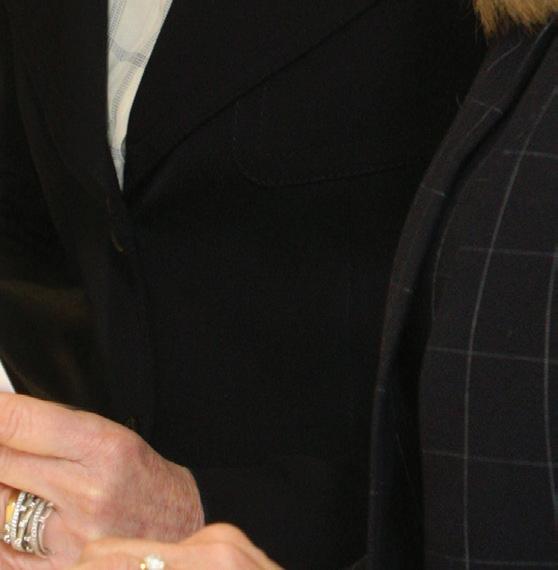
5 minute read
BATTLING SEIZURES










THE PEDIATRIC NEUROLOGY PROGRAM OFFERS STATEOF-THE-ART TESTING AND TREATMENT FOR CHILDREN WITH EPILEPSY.
Last summer, the Pediatric Neurology Program at Th e Unterberg Children’s Hospital at Monmouth Medical Center (MMC) welcomed two new pediatric neurologists: Rina Goldberg, MD, and Aviva Bojko, MD. With these experienced physicians at the helm, the program provides expert evaluation and treatment of children with a range of neurological problems—autism, epilepsy, attention defi cit hyperactivity disorder and headaches. Drs. Goldberg and Bojko, who are board-certifi ed in pediatric neurology and epilepsy, specialize in treating epilepsy, which aff ects about 470,000 children in the U.S., according to the Centers for Disease Control and Prevention.
COMPREHENSIVE TESTING
Epilepsy is marked by seizures, which occur as a result of a disruption in electrical communication between brain cells. Most cases are mild, and children usually outgrow the condition, says Dr. Goldberg. “Many children with epilepsy are likely to
To learn more or to make an appointment with a neurology specialist at Monmouth Medical Center, call 732.923.7790.
become seizure-free within two years,” she says. “Epilepsy is oft en curable. Even when it’s not, it doesn’t need to interfere with leading a productive life.” Th ere are several medications available to treat it—and new ones are being introduced every few years. (See “Th e Right Treatment.”)
Symptoms of epilepsy aren’t always clear-cut (see “Surprising Signs of Epilepsy”). “One of my patients had been treated for anxiety and wasn’t responding,” says Dr. Bojko. “One day, she fell on the floor and experienced a convulsion. No one realized that she was actually having seizures that manifested as anxiety.” The patient was admitted to the hospital, and testing showed that she was having seizures in the part of the brain
known as the right temporal lobe.
At MMC, testing is performed to determine whether a child suffers from epilepsy—and what type he or she has. Drs. Goldberg and Bojko use state-ofthe-art equipment known as a video EEG (electroencephalogram), which involves attaching metal discs called electrodes to the scalp to monitor electrical activity in the brain. Video is used to capture any behavioral changes and body movements that occur. It enables physicians to correlate brain waves with behaviors (for instance, the eyes rolling upward could be a seizure or a tic).
MMC offers four different types of EEG, which are performed by a certified EEG technician: • A routine EEG, which lasts for 20 minutes, with or without video • A four-hour video EEG, during From left: Jennifer Parise, Office Supervisor; Aviva Bojko, MD; Rina Goldberg, MD; Michelle Kovary, which a technician observes a child while NP; and Michelle Skokowski, CMA. Note: These photos were taken before mask and social distancing he or she is awake, drowsy and sleeping. recommendations were in place. “Sometimes abnormalities are only present when a child is drowsy or asleep,” says Dr. Goldberg. performed during EEG testing. The • An overnight video EEG, in which a child becomes an inpatient at MMC and is observed goal is to trigger abnormal brain waves, which indicate the child is likely to have a seizure. These tests include sleep THE RIGHT TREATMENT • A home EEG, in which a patient deprivation; photic stimulation, in which While the cause of epilepsy is brings the equipment home for 24 to 72 a strobe light is used to determine if often unknown, there can be a hours, with or without video vision abnormalities could be causing genetic component. There are
Sometimes additional tests are seizures; and hyperventilation, which many genes associated with epilepsy, and knowing which one a child carries can help a physician choose the most effective treatment to stop SURPRISING SIGNS OF EPILEPSY seizures, says Rina Goldberg, MD, Seizures—which occur when an abnormal group of brain cells starts firing—can be subtle, and they aren’t always recognized by parents and pediatricians. “If your child experiences abnormal movement out of the blue—and it occurs more than once—see a neurologist,” advises Aviva Bojko, MD, a pediatric neurologist. Here are some subtle symptoms that may indicate epilepsy: a pediatric neurologist. Treatment typically involves anticonvulsant medications. Occasionally, a child may have another condition as well, such as autism, migraine headaches or a mood disorder. • visual hallucinations Some medications can treat • a humming, buzzing or splashing sound epilepsy and another condition simultaneously. • a rising feeling in the chest or belly, which can be misinterpreted as anxiety • infantile spasm, in which a baby wakes up from a nap and flexes and extends his or her upper body—possibly with head nodding—and then cries. This may occur every few seconds over the course of five minutes and can be confused with colic. • unexplained tingling in the same body part that comes and goes • severe, unexplained vomiting at night • abnormal movement (eye blinking, shaking in the arms or legs, head movements) • sudden onset of body tics • chronic inattentiveness (staring off into space for about 10 seconds multiple times a day) involves rapid breathing. Video EEG can also be useful in evaluating children in the Emergency Department. If the test indicates a child is having a seizure, he or she can be treated right away. It can also be used to determine whether a seizure has stopped, says Dr. Goldberg. “State-of-the-art video EEG helps us to provide the best care for children with epilepsy,” she says.











